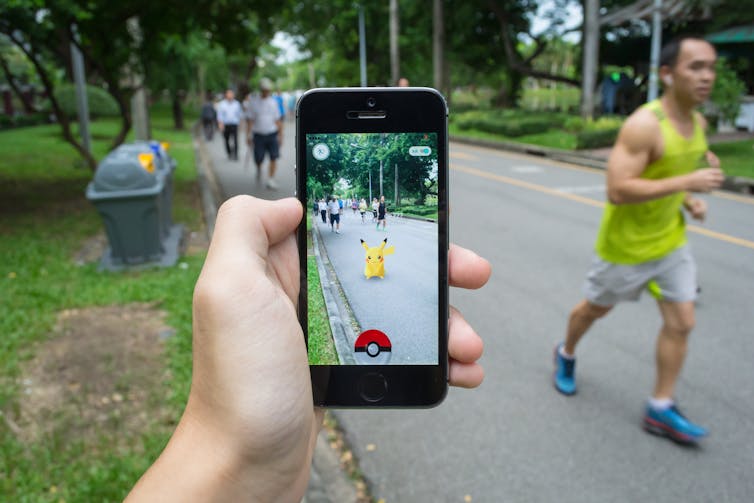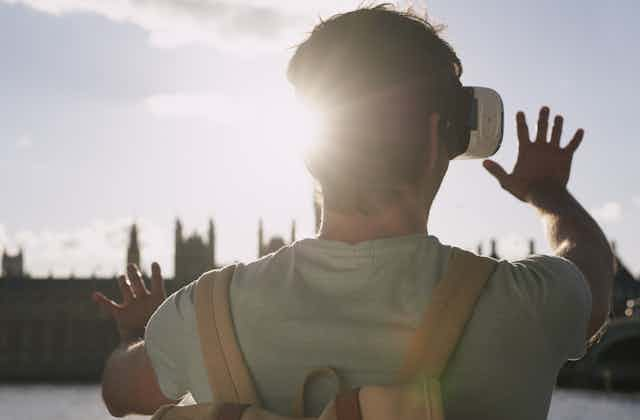SpaceX’s recent Falcon 9 rocket launch proves humanity has come leaps and bounds in its effort to reach other worlds. But now there’s a quicker, safer and environmentally friendlier way to travel to the centre of the galaxy – and you can do it too.
NASA has co-developed a free virtual reality (VR) adventure providing 500 years of travel around the black hole at the centre of the Milky Way. The experience is available to download from two major VR stores, Steam and Viewport, in a non-collapsed star system near you.
And this kind of spacefaring may be the tip of the iceberg when it comes to the potential of virtual travel and tourism.
Read more: Virtual reality adds to tourism through touch, smell and real people's experiences
The virtual travel bug
Simply speaking, VR refers to technology that immerses users in a computer-generated world that removes them from reality. Augmented Reality (AR), however, aims to superimpose virtual imagery over a user’s view of the real world. Pokémon Go is a popular AR game.

VR-based tourism has a longer history than you might think. In the 1850s, it involved staring at stereographs with a stereoscope. With this invention, viewers looked at slightly different images through each eye, which were then assembled by the brain to make a new image providing the illusion of spatial depth (in other words, a 3D effect).

A century later, 1950s Cinerama widescreen viewing inspired cinematic travel though its large, curved screens and multiple cameras.
The 1960s Sensorama foretold a shiny future of multimodal immersive cinematic experiences, playing 3D films with sound, scents and wind to immerse users. In VR circles, Ivan Sutherland became famous for inventing the head-mounted display, as well as augmented reality (AR).
Travel restrictions under COVID-19 present an opportunity for virtual reality travel to finally take off.
In an era of lockdowns and social distancing, we could use VR to travel to remote, distant or even no longer existing places. Remote tourism is here (the Faroe Islands offers a great example), and interest in VR tourism is blossoming.
VR comes in many forms
The word “virtual” can refer to an immersive 3D experience, but also 360° panorama photographs and movies (a cylinder, sphere or cube of photographs).
What is deemed “virtual” varies greatly across different devices and platforms. Let’s look at some of the ways this term is applied.
Desktop virtual environments: these are computer-based 3D environments on a flat screen, without the spatial immersion of VR platforms.
Cinematic VR: these are phone-based panoramic environments. Many desktop experiences of 360° movies or images can be conveyed in low-cost stereoscopic VR through smartphones. Google Street view can be viewed in Google VR on Android and some Apple smartphones, but it’s not real VR.

Head-mounted displays: HMDs such as Google Cardboard and Google Daydream are what many people think of when they hear “virtual reality”. Some HMDs are self-contained, not requiring connection to a computer or console. Arguably, the market is dominated by the Oculus range owned by Facebook, the HTC Vive range, and PlayStation VR.
VR in a pandemic
In a post-coronavirus age, device sharing is problematic. HMDs aren’t easy to clean and VR software can quickly become obsolete, with new headsets sometimes not running two-year-old software. Users also have to deal with costly updates, eyestrain, and having to share displays that sat on someone else’s face.
Developing and sharing content across different devices can be a nightmare but there are increasingly simple and effective ways to create AR and VR content, despite a bewildering range of platforms and equipment (there are more than 140 3D file formats).
Despite this, many VR projects are not preserved – including virtual heritage projects! Even for the largest HMD companies, supplies can be limited.
Places you can virtually visit now
Nonetheless, there are plenty of VR programs available to help relieve lockdown boredom, with many sites offering lists of their favourite picks.
The Street View app for Google Daydream and Cardboard provides a “virtual tour” of Chernobyl. Google Earth and Google Earth Voyager feature travel sections, too.
Google Earth VR is available on the HTC Vive and Oculus Rift. VRfocus also has an interesting travel section. You can virtually explore Switzerland or Yosemite.
Or you may want to stay in Australia. Australian company White Spark Pictures’ Cinematic/360 experience of Antarctica tours museums. Melbourne-based company Lithodomos brings “the ancient world to life” and Hidden AR offers mythical augmented reality.
Read more: What is augmented reality, anyway?
Other links to check out include:
- the Guardian’s review of the world’s best virtual museum and art gallery tours
- Google Arts and Culture’s virtual tours and online exhibits from myriad museums and galleries, as well as scavenger hunts – including at the British Museum
- the Louvre’s Mona Lisa: Beyond the Glass
- the VR Museum of Fine Art.
- Europeana’s vintage stereo VR and examples of how to create stories and lessons with stereosonic VR prints
- The Smithsonian’s virtual tour and downloadable 3D artefacts, including a tour of a hangar from the National Air and Space Museum
- Sketchfab’s cultural heritage section which can be accessed through VR headsets or Google Cardboard-enabled smartphones. There’s also a places and travel section.

Escapism through gaming
There are also VR games with which you can:
- escape inside a physical exhibition of Assassin’s Creed – Temple of Anubis VR
- travel through New Orleans, but with zombies
- tour medieval fantasy worlds via Skyrim VR
- explore alien worlds with No Man’s Sky on PlayStation VR
- watch Amazonian shamans, or
- explore Minecraft in VR.
VR can show your outer space, and also convey interpretations of time and space. With it, there is vast potential for travelling to infinity and beyond.

